|
|
|
|
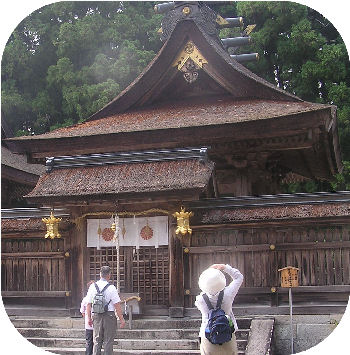 |
| the shrine with cypress bark roof |
|
5. Hongu Grand Shrine
August 27 |
|
Needless to say, this shrine is one of the Kumano Three Grand Shrines.
The main deity is Ketsumikono-ohkami.
The original shrine was built on a sand bank called Ohyunohara on the beach
of Kumano River during the days of Emperor Sujin (BC 97-30). But it was
washed away by the big flood in 1889. The remaining shrine buildings were
relocated at the present site on a hill. |
|
We arrived at the shrine gate late. The guide looked impatient, obviously
worrying about the next schedule.
We hastily paid homage at the shrine. I did not mind the short visit so
much because this was around my 10th time, however, how was the feeling
of everybody else including Emiko?
Hongu Grand Shrine must have been one of the big expectations for them.
I hoped to stay in the precincts at least 30 minutes there.
All of us got down the 129 stone steps from the shrine gate to the first
torii restlessly. |
|
|
After Hongu Grand Shrine, our bus rode along Kumano River to visit Hayatama
Shrine in Shingu City. Then the tour was planning to go to Katsuura Sightseeing
Hotel for the night.
Our couple parted from them when we arrived at Shingu City as the tour
conductor had admitted it before, and went to the graveyard of my parents,
without visiting Hayatama Grand Shrine.
Just after 5 p.m., we took the local bus at the stop "Hashimoto"
near Shingu Senior High School, my alma mater. We dropped off at the stop
"Koyo Junior High School of my another alma mater. The graveyard was
within a stone's throw. |
|
 |
|
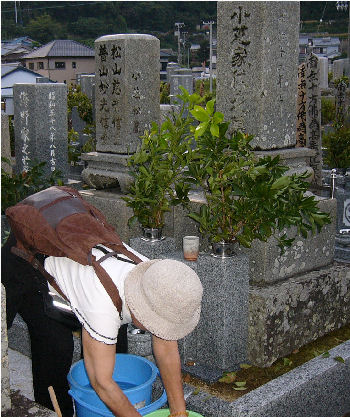 |
|
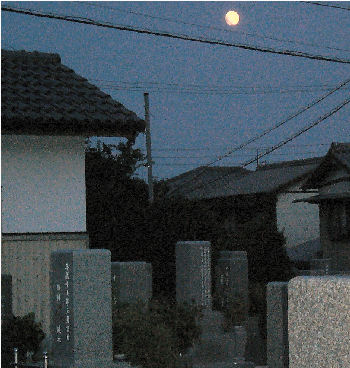 |
|
| Other Pictures at the Graveyard |
|
We had enough time at the grave.
Then we took the bus again and arrived at the hotel in Nachi-Katsuura Town
at 7:30 p.m.
Emiko and I hurried to the bath, so that we could relax and enjoy dinner in our room. |
| - - - - - - - - - - - - - - - - |
Since I visited Hongu Shrine today and am going to visit Nachi Shrine tomorrow,
I must mention the rakugo "Sanmai Kisho" (Three Written Vows)
as a rakugo mania.
As you might know, Rakugo (literally "fallen words") is a Japanese verbal entertainment. According to Wikipedia,
"The storyteller sits on stage. Using only a paper fan and a small cloth as props, and without standing up from the sitting position,
the rakugo artist depicts a long and complicated comical story. The story
always involves the dialogue of two or more characters, with the difference
between the characters depicted only through change in pitch, tone, and
a slight turn of the head."
"Makura" (introduction) is important in rakugo. In this story
"Sanmai Kisho" the makura by Katsura Beicho is as follows.
|
|
| It has been long since the greatest rakugo artist Kokontei Shinsho passed away. He told this story so nicely, even if it is a Kamigata (Osaka) story and he was Tokyoite. I have approached his age now. He used to tell the stories as if he had been living just in Edo period. I hope I would cheat you in the near future like him |
|
|
|
The monologue always ends with a narrative stunt known as ochi (literally "fall"), consisting of a sudden interruption of a wordplay flow.
The following ochi of "Sanmai Kisho" is by Kokontei Shinsho. |
|
Arguing between
Master Builder and Prostitute Kisegawa |
|
Master Builder: Hey, you, Kisegawa. You see. I really know it' a prostitutes'
business to cheat guests. Therefore I don't complain anything about your
cheating. I just feel disappointed by your way of cheating. According to
an old allegory, if you write such a vow, it means you will kill three
holly crows. Don't do such a horrible thing.
Kisegawa: Well, I see. Will three crows die? Is it true? Don't say that
again. I want to write a lot of vows and to kill all the crows in the world.
Master Builder: What do you want by doing so?
Kisegawa: I want to sleep in. |
|
|
|
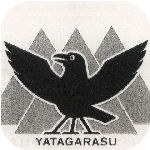
Yatagarasu
a crow with 3 legs |
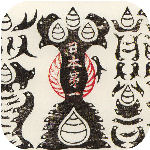
Hongu Grand Shrine |

Nachi Grand Shrine |
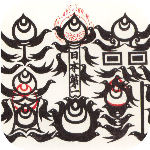
Hayatama Grand Shrine |
|
|
|
| Part 5 Reading: 8' 54" |
|
|
|
|
|
|
|
| Mail |
|
|